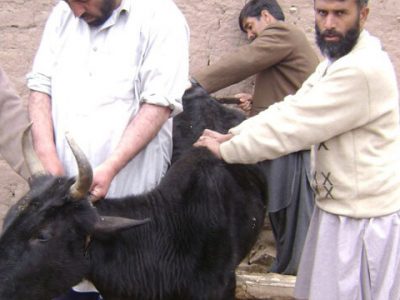Livestock losses to predator attacks can be devastating to herder families in snow leopard habitat across Central Asia; and they remain a primary source of human-wildlife conflicts. Through interventions like our community-based livestock insurance and vaccination programs, we’ve found ways to help local herders better absorb the financial impact of livestock losses – and people’s attitudes towards the cats have improved as a consequence.
In order to foster an even stronger acceptance of snow leopards among local herders, we’re also working on preventing livestock losses from happening in the first place – by creating incentives for more careful herding practices, and by building predator-proof corrals with herding communities.
The problem
Livestock losses to predation are part of everyday life for many herding communities in Central Asia. In some of our program areas, an average household will lose roughly one animal per year, which can equal about one monthly income for a family. As a result, snow leopards and other predators are sometimes persecuted and killed by herder.
A significant percentage of predation incidents on livestock happens at unsecured corrals. If the predator manages to enter a corral where livestock are confined, results can be catastrophic for herders, as the cat’s instincts might lead to it killing several animals in one incident.
Predation incidents also occur in pastures, particularly on livestock that’s left to roam freely, or on stragglers that have been separated from the herd.
In some cases, herders catch a snow leopard in the act, and shoot the cat to protect their livestock. Other times, the damage is discovered the next day. Either way, tolerance for the predator suffers, and retaliation often appears to herders as their only option.
Preventing predation directly helps reduce a major threat to snow leopards, and is an immediate response to a pressing issue for many communities in snow leopard habitat. It’s often an excellent project to build a relationship of mutual trust.
The solution
Many predation incidents can be prevented if corrals are predator-proof.
Depending on the area, and the prevailing herding practices, predator-proofing can take on different forms.
In Pakistan, many communities have traditionally shared large corrals, holding the livestock of several families. These are usually solid constructions of stone and wood – but their doors and roofs are often unsecured. The same is true for most family corrals in the Indian Himalayas. Metal window grates, solid wooden doors and poles and wire mesh for the roof can make all the difference here!
In India, some of our partner communities whom we’ve helped improve their corrals have reported up to 90% fewer predation incidents.
In Mongolia’s South Gobi, many herders are semi-nomadic, living in gers and moving their livestock around quite frequently.
During the winter, however, they keep the animals in unfortified holding pens overnight to protect them from the relentless winds. These pens have low walls and are easy for predators to access.
After experimenting with different approaches, our team has found fences to be the best solution to keep predators away here. Results have been very encouraging: none of the 10 families participating in our 2014 corral pilot project in the South Gobi have suffered further livestock losses.
In all our corral improvement projects, we partner with the local community on sharing costs, and corral owners usually provide much of the labor. This not only reduces the financial investment, but also creates a sense of ownership and responsibility in the community.
Predation incidents in pastures can never be prevented altogether, but their number could potentially be reduced through improved herding practices. For instance, avoiding very rugged areas of the pastures can help herders keep sight of their animals and reduces the risk of stragglers being left behind overnight.



